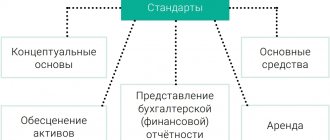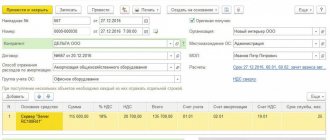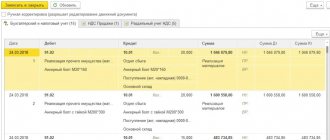Instruction 174n with changes for 2021 - changes in the chart of accounts (account 101)
Let's look at the main changes in account 101 00 000 “Fixed Assets”:
1. New wiring has appeared. When fixed assets are transferred for financial lease (gratuitous perpetual use) by the lessor (lender), the disposal of fixed assets classified as non-operating (financial) environment objects is reflected in the following entries:
| DEBIT account 0 401 10 172 “Income from transactions with assets” of the corresponding analytical accounting accounts: |
| 0 104 00 000 “Depreciation” |
| 0 114 00 000 “Impairment of non-financial assets” |
| CREDIT of the corresponding analytical accounting accounts account 0 101 00 000 “Fixed assets” |
2. A new group 00 “Fixed assets – property in concession” and analytical accounting accounts were introduced:
| Analytical accounting account | Account names |
| 0 101 91 000 | “Residential premises = property in concession” |
| 0 101 92 000 | “Non-residential premises (buildings and structures) – property in concession” |
| 0 101 94 000 | “Machinery and equipment – concession property” |
| 0 101 95 000 | “Vehicles – concession property” |
| 0 101 97 000 | “Biological resources – property in concession” |
| 0 101 98 000 | “Other fixed assets – property in concession” |
3. The group of accounting accounts 0 101 40 000 “Fixed assets – leased items” and analytical accounts for it (0 101 (41 – 48) 000) are excluded.
4. The following accounts have been excluded:
| Analytical accounting account | Account name |
| 0 101 18 000 | “Other fixed assets – real estate of the institution” |
| 0 101 21 000 | “Residential premises are particularly valuable movable property of an institution” |
| 0 101 23 000 | “Structures are especially valuable movable property of an institution” |
| 0 101 31 000 | “Residential premises – other movable property of the institution” |
| 0 101 43 000 | “Structures – leased items” |
5. Certain account names have been changed:
| Account name in the old version | Name of the account in the new edition |
| 0 101 26 000 “Industrial and business equipment - especially valuable movable property of the institution” | 0 101 26 000 “Industrial and economic equipment - especially valuable movable property of the institution” |
| 0 101 27 000 “The library collection is a particularly valuable movable property of the institution” | 0 101 27 000 “Biological resources are particularly valuable movable property of the institution” |
| 0 101 33 000 “Structures – other movable property of the institution” | 0 101 33 000 “Investment real estate” – other movable property of the institution |
| 0 101 36 000 “Industrial and business equipment - other movable property of the institution” | 0 101 36 000 “Industrial and economic inventory - other movable property of the institution” |
| 0 101 37 000 “Library collection – other movable property of the institution” | 0 101 37 000 “Biological resources – other movable property of the institution” |
Typical calculation errors
Mistake #1. A budgetary enterprise determines the amount of income taking into account VAT, sales tax and excise taxes.
Income from the sale of goods, work performed and services provided, income from the sale of property rights and non-operating income of budgetary institutions are determined in the manner established by Art. 249 of the Tax Code of the Russian Federation (excluding VAT, excise taxes, sales tax).
Mistake #2. Some expenses of a budgetary institution, which are not related to business activities and should have been financed from targeted financing, were covered by the business activities of the same enterprise.
It is allowed to direct funds to cover the costs of a budgetary institution, which should be covered from targeted financing, only from net profit from commercial activities (after identifying financial results and paying income tax).
Instruction 174n with changes for 2021 - changes in the chart of accounts (account 102)
On account 102 00 000, as in the old version of the Instructions, intangible assets are taken into account. But the changes affected this account too - analytical accounting accounts 0 102 40 000 “Intangible assets - leased items” were excluded.
That is, currently only 2 accounts are used to generate information about the presence of business transactions and intangible assets: (click to expand)
| Analytical accounting account | Account name |
| 0 102 20 000 | “Intangible assets are especially valuable movable property of an institution” |
| 0 102 30 000 | “Intangible assets - other movable property of an institution” |
Instruction 174n with changes for 2021 - changes in the chart of accounts (account 103)
Non-productive assets are subject to accounting in account 103 00 000. After making adjustments to the Instructions, the following groups of accounts are now used to account for non-productive assets:
| Account group | Name |
| 0 103 10 000 | Non-productive assets – real estate of the institution |
| 0 103 30 000 | Non-productive assets – other movable property |
| 0 103 90 000 | Non-productive assets – as part of the grantor’s property |
Previously used analytical accounting accounts belong to the 1st group. New accounts have been introduced for groups 30 and 90:
| Check | Name |
| 0 103 32 000 | Subsoil resources – other movable property of the institution |
| 0 103 33 000 | Other non-produced assets – other movable property of the institution |
| 0 103 91 000 | Land is part of the grantor's property |
Responsibility for evasion of income tax
When budgetary organizations discover errors in the payment of income tax, they should correct them themselves, recalculate the tax, pay the difference and penalties to the budget for the period until the error was identified, and send an updated declaration to the tax service.
Otherwise, a fine will be imposed on the institution, calculated on the basis of the amount of arrears minus the amounts of overpayments available in the institution. A penalty will also be charged for each day of late payment. In case of malicious violation of tax laws, penalties will be toughened up to the point of bringing the management of the enterprise to criminal liability.
Instruction 174n with changes for 2021 - changes in the chart of accounts (account 104)
Account 104 00 000 “Depreciation” for accounting for depreciation charges has been adjusted to a significant extent:
1. Accounts excluded:
| Analytical accounting account | Name |
| 0 104 18 000 | Depreciation of other fixed assets – real estate of the institution |
| 0 104 21 000 | Depreciation of residential premises – especially valuable movable property of an institution |
| 0 104 23 000 | Depreciation of structures - especially valuable movable property of the institution |
| 0 104 31 000 | Depreciation of residential premises - other movable property of the institution |
| 0 104 43 000 | Depreciation of structures – leased items |
2. The name of the accounting group for account 0 104 40 000 has changed. Now the name is “Depreciation of rights to use assets”, previously it was “Depreciation of leased items”.
3. A new accounting group for account 0 104 40 000 “Depreciation of property in concession” was introduced.
4. New budget accounting entries have appeared:
| Operation | DEBIT | CREDIT |
| Termination of the right to use assets upon early termination of the agreement under which operating lease items were taken into account (disposal of an accounting item) must be reflected in the amount of accumulated depreciation of the right to use assets. | ... corresponding analytical accounting accounts account 0 104 40 000 “Depreciation of rights to use assets” | ... corresponding analytical accounting accounts account 0 111 40 000 “Rights to use non-financial assets” |
| Termination of the right to use an asset (subject to full execution of the contract) (disposal of an accounting object) must be reflected in the amount of the book value of the right to use the assets. | ... corresponding analytical accounting accounts account 0 104 40 000 “Depreciation of rights to use assets” | ... corresponding analytical accounting accounts account 0 111 40 000 “Rights to use non-financial assets” |
Which budgetary institutions do not pay income tax?
The object of income taxation appears in a budgetary enterprise only when it carries out commercial activities. Accordingly, if a budgetary organization is exclusively engaged in carrying out tasks of state and municipal departments at the expense of subsidies and relevant budgets, the results of its work are not subject to corporate income tax.
The following categories of cash receipts do not include income (accordingly, they are not subject to income tax):
- income in the form of property paid in advance (not taken into account for those who use the accrual method),
- income in the form of property provided as collateral for the fulfillment of any obligations,
- free assistance, recognized as gratuitous when provided by foreign states,
- income in the form of property from state or municipal enterprises,
- granted grants,
- targeted receipts (money from budgets of any level and from individuals to carry out the main activities of a budgetary institution),
- donations in any form,
- other income listed in Art. 251 Tax Code.
Expenses not taken into account for income tax purposes include:
- dividends accrued after taxes (including income tax),
- contributions to the authorized capital of other organizations,
- fines and penalties imposed on the institution for violation of tax obligations,
- voluntary membership contributions to public organizations,
- donation of property to individuals and legal entities,
- money donated to trade unions
- other costs listed in Art. 270 Tax Code.
Instruction 174n with changes for 2021 - changes in the chart of accounts (account 106)
Account 106 00 000 “Investments in non-financial assets” has also undergone some changes: (click to expand)
- Added account 0 106 33 000 “Investments in non-produced assets - other movable property of the institution.”
- The account group 0 106 90 000 “Investments in the property of the grantor” and analytical accounts for it were introduced: 0 106 91 000 “Investments in fixed assets in the concession” and 0 106 93 000 “Investments in non-produced assets in the concession”.
- Count group 40 has been renamed. Instead of the old name “Investments in leased objects” the name “Investments in financial lease objects” is now used.
For this reason, the following analytical accounting accounts were excluded:
| Check | Name |
| 0 106 41 000 | Investments in fixed assets – leased items |
| 0 106 42 000 | Investments in intangible assets – leased items |
| 0 106 44 000 | Investments in inventories – leased items |
Instruction 174n as amended for 2021 - changes in the chart of accounts (account 0 111 00 000)
On the analytical accounting accounts of account 0 111 00 000 “Rights to use assets”, the following operating lease objects are recorded:
| Analytical accounting account | Name |
| 0 111 41 000 | Rights to use residential premises |
| 0 111 42 000 | Rights to use non-residential premises (buildings and structures) |
| 0 111 44 000 | Rights to use machinery and equipment |
| 0 111 45 000 | Rights to use vehicles |
| 0 111 46 000 | Rights to use industrial and household equipment |
| 0 111 47 000 | Rights to use biological resources |
| 0 111 48 000 | Rights to use other fixed assets |
| 0 111 49 000 | Rights to use non-produced assets |
Registration of transactions to reflect the rights to use assets:
| Operation | DEBIT | CREDIT |
| Recognition of an operating lease accounting object as a lessee (property user) | ... corresponding analytical accounting accounts account 0 111 40 000 “Rights to use non-financial assets” | Accounts 0 302 24 730 “Increase in accounts payable for settlements of rent for the use of property”; 0 302 29 730 “Increase in accounts payable for payments of rent for the use of land plots and other isolated natural objects” |
| Receipt of non-financial assets related to the objects of accounting for operating leases on preferential terms for free-term use in accordance with the agreement, reflected by the institution (user) of non-financial assets in the amount of the fair value of lease payments. | ... corresponding analytical accounting accounts account 0 111 40 000 “Rights to use non-financial assets” | … account 0 401 40 182 “Deferred income from gratuitous right of use” |
| Termination of the right to use an asset (if the contract is fully executed) (disposal of an accounting object) in the amount of the book value of the right to use the asset | ... corresponding analytical accounting accounts account 0 104 40 000 “Depreciation of rights to use assets” | ... corresponding analytical accounting accounts account 0 111 40 000 “Right to use non-financial assets” |
| Termination of the right to use an asset upon early termination of the agreement under which operating lease accounting items were taken into account (disposal of an accounting item) | The “red reversal” method in the amount of the residual value of the right to use the asset: DEBIT of the corresponding analytical accounts of account 0 111 40 000 “Rights to use non-financial assets” | CREDIT accounts 0 302 24 730 “Increase in accounts payable for settlements of rent for the use of property”, 0 302 29 730 “Increase in accounts payable for payments of rent for the use of land plots and other isolated natural objects”, 0 401 40 182 “Future income from gratuitous right of use.” |
| In the amount of accumulated depreciation of the right to use the asset: DEBIT of the corresponding analytical accounting accounts, account 0 104 40 000 “Depreciation of the right to use assets” | CREDIT to the corresponding analytical accounting accounts account 0 111 40 000 “Rights to use non-financial assets” |
A phased rollout of accounting standards will begin in 2021.
Five of them have been accepted and published so far. • Conceptual framework of accounting and reporting for public sector organizations
• Presentation of accounting (financial) statements
• Fixed assets
• Rent
• Impairment of assets
Let's start our acquaintance with the standard - “Fixed Assets”. What will change in accounting for fixed assets in 2021?
The new standard was approved by order of the Ministry of Finance of Russia dated December 31, 2016 No. 257n. The changes came into force on January 1, 2021.
Read about how to transfer fixed asset balances to new accounts in the article “Accounting for fixed assets in 2021.”
The grouping of fixed assets will change: non-residential premises are combined into one group with buildings and structures, perennial plantings will have a separate group, whereas previously they were usually classified as other fixed assets. But the library collection will not be allocated to a separate group. The new grouping of fixed assets does not directly correspond to the recently introduced OKOF classifier, as it was before.
A new concept is emerging: “investment real estate” - this is real estate owned by an institution and rented out by it, or is an investment, i.e. increases the value of real estate. The group is new, which means it will be necessary to analyze all your real estate assets and, if they meet the established criteria, move them to this group. In the new charts of accounts, separate accounts have appeared for accounting for investment real estate - 10113 and 10133. For more information on how to transfer objects to new accounts, read the article “Accounting for fixed assets in 2021.”
The “Fixed Assets” standard raises the limits on the cost of fixed assets when determining the procedure for calculating depreciation. However, recalculate depreciation for property accepted for accounting before 01/01/2018. no need!
Now fixed assets worth up to 10 thousand rubles (3 thousand previously) will be considered low-value. Such objects, as before, are immediately written off from the balance sheet to 21 off-balance sheet accounts.
For library collections, a separate rule is 100% depreciation for a cost of up to 100 thousand.
For fixed assets worth from 10 to 100 thousand rubles, depreciation will be charged at the rate of 100% upon commissioning, just as before for objects from 3 to 40 thousand rubles.
But with fixed assets over 100 thousand, it’s not so clear. With the entry into force of the Standard, you need to independently determine the depreciation method for such fixed assets.
What to look for when choosing a depreciation method?
For an OS costing over 100 thousand rubles, the method should be chosen depending on how and for what the object will be used. Those. The method must most accurately reflect the expected manner in which future economic benefits or utility potential will be achieved.
For example, if equipment is used frequently to provide a service and wears out quickly, you can charge depreciation based on the volume of services.
In total, in 2021 you will need to choose from three methods:
- Straight-line method - depreciation is charged evenly over the useful life
- Declining balance method - based on the residual value of the object at the beginning of the reporting year and the depreciation rate
- Proportional to output – based on the expected use or expected performance of the asset
Important!




